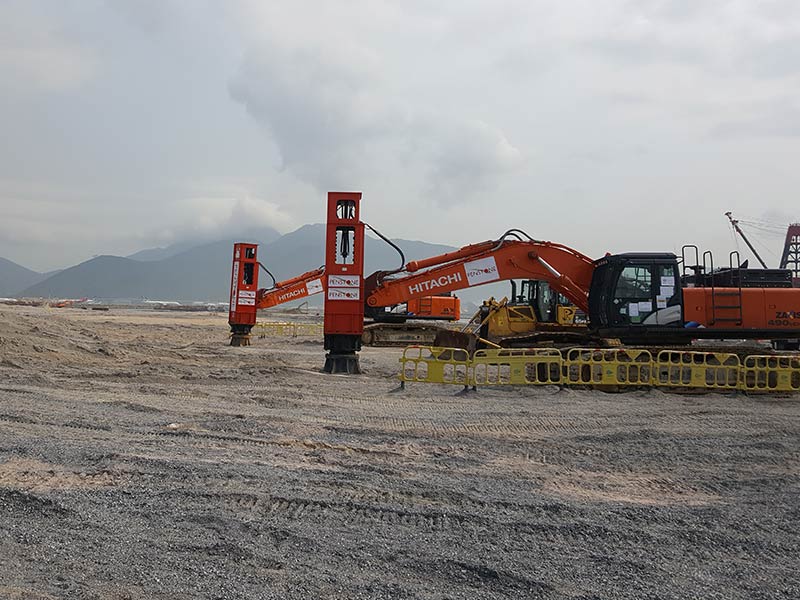what is "rapid" about rapid impact compaction? HENGDA
- Update time:2022-12-02 15:14:01
- Views:332
The RIC compactor is mounted on a excavator so that moving around the site is easy. The compactor consists of a 7.5-ton weight falling approximately 36 inches onto an anvil in contact with the ground at a rate of approximately 40-90 blows per minute thereby compacting approximately 800 sf of area per hour. Onboard diagnostics equipment allows the compaction effort to be stopped when optimum compaction has been achieved.

RIC increases the stiffness and shear strength of soils through the use of impact compaction effort. Specific benefits include:
Increases Standard Penetration Resistance – the standard penetration resistance (N-Values) of loose granular soil can increase significantly. In developing an RIC specification for a project the minimum target blow count for the performance required should be specified.

Use within 30 feet of a Building – Because Rapid Impact Compaction provides a low magnitude of impact loading at a very high frequency, the peak particle velocity remains relatively low (less than 2 inches per sec) at a distance of 30 feet from the source. This is different from Deep Dynamic Compaction which has a low frequency and a high magnitude of loading so vibrations are greater from DDC when compared to RIC.

Rapid Impact Compaction (RIC) is a ground improvement technique that densifies shallow, loose and, granular soils. Soil treated by this method results in increased density, friction angle, and overall stiffness, which results in increased bearing capacity and decreased settlement of planned structures. Rapid Impact Compaction consists of an excavator-mounted, hydraulic pile-driving hammer repeatedly striking a circular plate that rests on the ground. Energy is then transferred to the ground safely and efficiently, as the RIC’s foot remains in contact with the ground, which avoids concern over flying debris being ejected. Rapid Impact Compaction densifies loose-fill soils of up to 6 m deep or more. Additional benefits of rapid compaction include: an increase of the bearing capacity of the soils, minimization of settlement, and the creation of uniform support for foundation footing. Rapid Impact Compaction is an innovative solution when compared to the time and cost of over-excavation and re-compaction.

A compaction plate is placed on the ground to be treated. A hydraulic hammer, generally weighing less than 10 to 15 tonnes, is fitted to an excavator and used to transmit compaction energy to the soil via repeated impact. Without specific site precautions, a safe working distance to sensitive structures can usually be defined on the order of 8 to 10 m, as a distance of 5 to 6 m can usually be adopted for classical structures. At that distance, noise levels are lower than 90 dBA.

The energy and deflection of the soil is monitored and recorded at each location, which allows the geotechnical engineer to determine when effective treatment is complete. It also enables the engineer to identify weak zones (red dots) or debris zones throughout the pad so that any remedial actions that may be required can be minimized resulting in cost savings.
- 2022-08-15What is the appropriate depth of rapid impact compaction?
- 2022-08-13Rapid Impact Compaction History In China - RIC 夯神
- 2022-12-23Why should I use rapid impact compaction ground improvement?
- 2022-12-26What are the three types of compaction? HENGDA RIC
- 2022-12-02what is "rapid" about rapid impact compaction? HENGDA
- 2023-02-09Rapid impact compaction ltd - HENGDA RIC
- 2023-01-29What does it mean to have 95% compaction? - HENGDA RIC
- 2023-01-28How do I know if my soil is compacted enough? - HENGDA RIC
- 2022-12-29Rapid impact compactor for sale - 10 ton RIC
- 2022-08-15Construction specification for rapid impact compaction treatment of foundations
- 2022-09-28Rapid impact compaction under construction at Dubai Airport in UAE
- 2022-08-15Rapid impact compactor under construction at Xiamen Airport in China
- 2022-08-15Rapid impact compaction (ric) method commonly used for
- 2022-08-15Rapid impact compactor at the construction site of Jazan Airport in Saudi Arabia
- 2022-08-15What is rapid impact compaction method? - Rapid impact compaction manufacturer
- 2022-08-15HC36 Rapid Impact Compaction Equipment in Jiangxi Highway Construction in China
- 2022-08-15Rapid impact compaction in China's Guangdong high-speed construction
- 2022-08-15What is Rapid Hydraulic Compactor? - Rapid Hydraulic Compactor China Supplier
-
Rapid Impact Compaction machine tamping depth - how many hammers for Rapid Impact Compaction machine
Take the widely used rapid impact compaction machine as an e...
-
Rapid Impact Compaction equipment manufacturer-Rapid Impact Compaction debugging equipment
Rapid impact compactors have two compaction forms in practic...
-
Rapid Impact Compaction Operation Video Daquan-Rapid Impact Compactor Operation Video Tutorial
Rapid impact compaction has remarkable effect in foundation ...
- Hengda Machinery Co., Ltd
How much is the price of rapid impact compaction, model parameters, etc.


